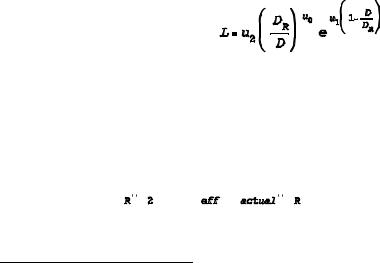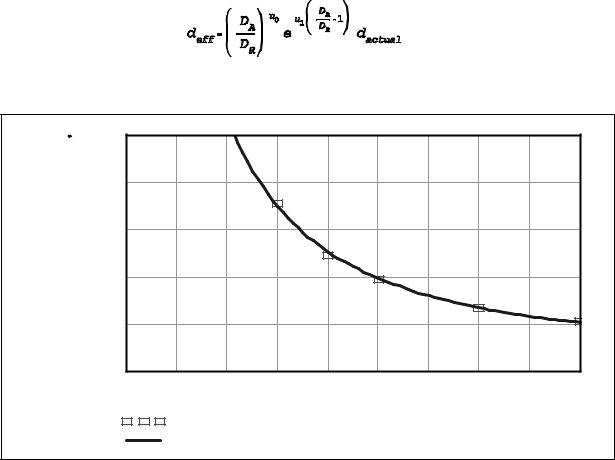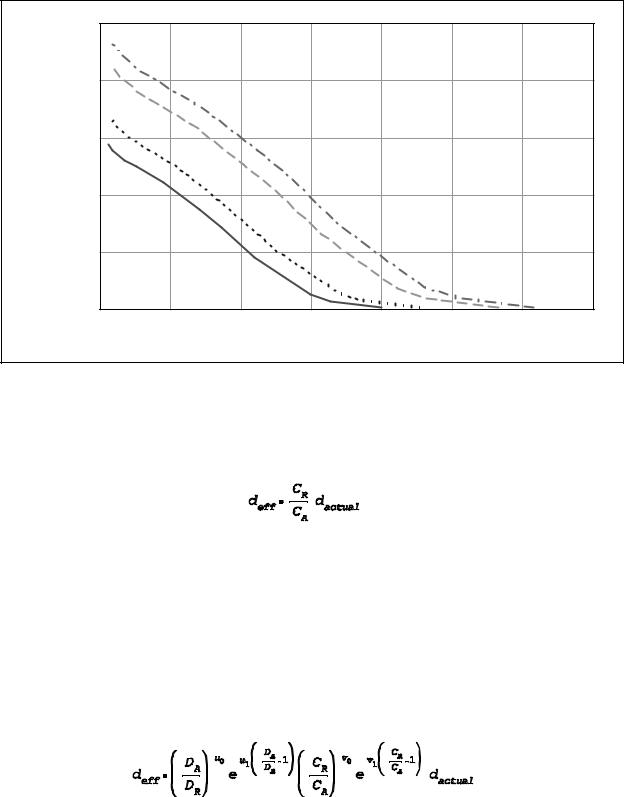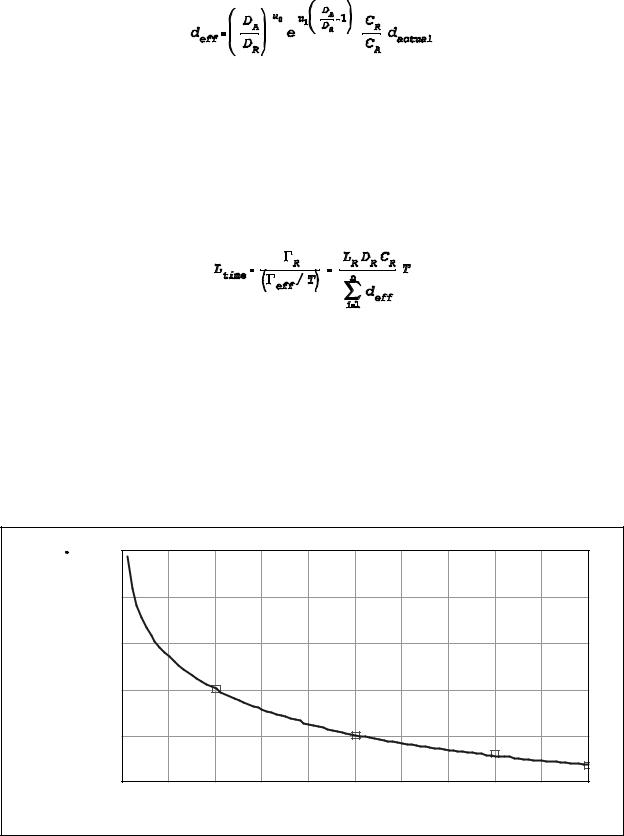
курсова_1 / 1997
.pdf
NREL/CP-440-21978
A Battery Life Prediction Method for Hybrid Power Applications
Preprint
S. Drouilhet
National Renewable Energy Laboratory
B.L. Johnson
Integrated Power Corporation
To be presented at the 35th AIAA Aerospace
Sciences Meeting and Exhibit
Reno, Nevada
January 6-9, 1997
National Renewable Energy Laboratory 1617 Cole Boulevard
Golden, Colorado 80401-3393
A national laboratory of the U.S. Department of Energy Managed by Midwest Research Institute
for the U.S. Department of Energy
under contract No. DE-AC36-83CH10093
Work performed under task number WE712360
January 1997

NOTICE
This report was prepared as an account of work sponsored by an agency of the United States government. Neither the United States government nor any agency thereof, nor any of their employees, makes any warranty, express or implied, or assumes any legal liability or responsibility for the accuracy, completeness, or usefulness of any information, apparatus, product, or process disclosed, or represents that its use would not infringe privately owned rights. Reference herein to any specific commercial product, process, or service by trade name, trademark, manufacturer, or otherwise does not necessarily constitute or imply its endorsement, recommendation, or favoring by the United States government or any agency thereof. The views and opinions of authors expressed herein do not necessarily state or reflect those of the United States government or any agency thereof.
Available to DOE and DOE contractors from:
Office of Scientific and Technical Information (OSTI)
P.O. Box 62
Oak Ridge, TN 37831
Prices available by calling 423-576-8401
Available to the public from:
National Technical Information Service (NTIS) U.S. Department of Commerce
5285 Port Royal Road
Springfield, VA 22161 703-605-6000 or 800-553-6847 or
DOE Information Bridge http://www.doe.gov/bridge/home.html
Printed on paper containing at least 50% wastepaper, including 10% postconsumer waste
A Battery Life Prediction Method for Hybrid Power Applications
Stephen Drouilhet, P.E.
National Renewable Energy Laboratory
Bertrand L. Johnson, P.E.
(formerly of the Princeton Economic Research, Inc.)
Integrated Power Corporation
Abstract
Batteries in hybrid power applications that include intermittent generators, such as wind turbines, experience a very irregular pattern of charge and discharge cycles. Because battery life is dependent on both depth and rate of discharge (and other factors such as temperature, charging strategy, etc.), estimating battery life and optimally sizing batteries for hybrid systems is difficult. Typically, manufacturers give battery life data, if at all, as cycles to failure versus depth of discharge, where all discharge cycles are assumed to be under conditions of constant temperature, current, and depth of discharge. Use of such information directly can lead to gross errors in battery lifetime estimation under actual operating conditions, which may result in either a higher system cost than necessary or an undersized battery bank prone to early failure. Even so, most current battery life estimation algorithms consider only the effect of depth of discharge on cycle life.
This paper will discuss a new battery life prediction method, developed to investigate the effects of two primary determinants of battery life in hybrid power applications, varying depths of discharge and varying rates of discharge. A significant feature of the model is that it bases its analysis on battery performance and cycle life data provided by the manufacturer, supplemented by a limited amount of empirical test data, eliminating the need for an electrochemical model of the battery. It performs the analysis for a user-prescribed discharge profile consisting of a series of discharge events of specified average current and duration. Sample analyses are presented to show how the method can be used to select the most economical battery type and size for a given hybrid power system application.
1.Introduction
Renewable energy-based hybrid power systems typically combine one or more forms of renewable energy generation (e.g. wind and photovoltaic) with a conventional power source (e.g. diesel generator) to provide continuous reliable power. Applications for such isolated power systems include, remote telecommunication sites, village power in rural areas without grid access, remote military and other government facilities. To maximize utilization of the available renewable resource and/or to minimize use of the backup generator, hybrid power systems usually incorporate some amount of energy storage, and given the experimental status of most other energy storage technologies, batteries are almost always used.
2
The available power from renewable energy components, particularly wind turbines, is highly variable and somewhat random. Consequently, batteries in hybrid power systems experience a very irregular pattern of charge and discharge cycles. Because battery life is dependent on both depth and rate of discharge (and other factors such as temperature, charging strategy, etc.), estimating battery life and optimally sizing batteries for hybrid systems is difficult. Typically, manufacturers give battery life data, if at all, in terms of cycles to failure versus depth of discharge, where all discharge cycles are assumed to be under conditions of constant temperature, current, and depth of discharge. Use of such information directly in estimating in battery under actual operating conditions can lead to gross errors, which may result in either a higher system cost than necessary or an undersized battery bank prone to early failure. Even so, most current battery life estimation algorithms consider only the effect of depth of discharge on cycle life.
This paper discusses a new battery life prediction method, developed to help quantify the effects of two primary determinants of battery life in hybrid power applications, varying depths of discharge and varying rates of discharge. A significant feature of the method is that it bases its analysis on battery capacity and cycle life data provided by battery manufacturers (perhaps supplemented by a limited amount of additional test data), eliminating the need for an electrochemical model of the battery. It performs the analysis for a user-prescribed discharge profile consisting of a series of discharge events of specified average current and duration. An example analysis is presented to show how the method can be used to help select the most economical battery type and size for a given hybrid power system application.
2.Factors Affecting Battery Life
When considering battery life, one can distinguish between battery aging and battery wear. Battery aging refers to those factors or processes that tend to limit the duration of the battery’s physical integrity and its ability to perform its intended function. Battery wear refers to those factors or processes that tend to limit the amount of electric energy that can be stored or delivered. Corrosion is a major component of battery aging, particularly in lead-acid batteries, which are the most common. All batteries, however, are subject to processes that tend to deteriorate and contaminate the plates and/or electrolyte, so that even in continuous float service battery life time is limited. Ageing, of course can be greatly accelerated by adverse environmental conditions or improper maintenance, but these things can presumably be controlled. Battery wear, on the other hand, is much more a function of the particular charge/discharge history the battery is subjected to. An abusive use pattern can cause a battery to fail long before it would cease to be viable merely through aging processes. The life prediction method described here does not address battery aging; it only attempts to predict battery life based on accumulated wear.
A further distinction to be made is between the life of an individual cell and the useful life of a collection of cells in a large battery bank. Small differences between cells in plate availability, state of charge, and temperature can become quite pronounced with repeated cycling of the battery. If these differences are not corrected, the weak cells will drag down the whole battery string, resulting in premature failure. The present analysis is concerned with individual cell life under prescribed discharge pattern. We assume that the battery receives proper periodic equalization charges and

3
relatively uniform battery temperature control.
Many factors contribute to the useful life of a battery cell in a given application. These include depth of discharge, discharge rate, cell temperature, charging regime, dwell time at low and high states of charge, battery maintenance procedures, current ripple, and amount and frequency of overcharge. The system designer and/or operator has some degree of control over all of these factors except depth of discharge and discharge rate. Once a battery is selected to meet a given load, the power demanded by the load will determine the depth and rate of discharge, which is why these two factors are the focus of this life prediction method. Strictly speaking, in some hybrid power applications, particularly where battery recharging is done primarily with renewable energy, there is very little control over charge rate either. However, there is some evidence that high charge rates at low and intermediate states of charge are not harmful to battery life (and in fact may increase it)1, and until more research is done in this area, we will not consider the effect of charge rate in our model.
3.Battery Life Prediction Method
The battery life prediction method presented in this paper is based on three premises put forth by Symons2, which are paraphrased here:
Premise 1: Each cell has a finite life as measured by the sum of the effective ampere-hours throughput during its useful life. The effective ampere-hours are defined here as the actual ampere-hours as modified by the other two premises cited below. When the cumulative effective ampere-hours (the total of the individual effective amp-hours corresponding to a series of discharge “events”) equals the rated charge life of the cell, the cell is will have reached its useful life. The rated charge life 'R of the cell is defined as
(1)
where |
C |
= rated amp-hour capacity at rated discharge current I |
|
|
R |
|
R |
|
D = depth of discharge for which rated cycle life was determined |
||
|
R |
|
|
|
L |
= cycle life at rated depth of discharge D |
and discharge current I |
|
R |
R |
R |
This premise assumes that the operating conditions of the cell other than depth of discharge and discharge rate are similar to the reference conditions (temperature, periodic boost charge, float voltage, etc.) under which the rated cycle life was determined.
It is well known that cell cycle life decreases with increasing depth of discharge. It is frequently assumed however, that the charge life (total amp-hours throughput) of the battery is constant, i.e. independent of depth of discharge. Premise 2 contradicts this assumption.
Premise 2: The actual charge life (total ampere-hours throughput) of the cell, not just its

4
cycle life, is a function of the depth of discharge at which it is cycled.a Alternatively stated, the effective ampere-hour discharge in a given discharge event may be more or less than the actual discharge, depending on the actual depth of dischargeb relative to the rated depth of discharge. We assume here that, providing the cell is fully charged on a reasonably frequent basis, there will be no reduction in life if it is not fully recharged every cycle.
Premise 3: The charge life of the cell, ', will be decreased whenever the cell is discharged at a rate faster (higher discharge current) than the rated rate. Furthermore, the reduction in life will have a close functional relationship to the observed reduction in ampere-hour capacity with increasing discharge rate.c Alternatively stated, the ratio of the effective amperehour discharge to the actual discharge at a certain discharge rate and duration will be functionally related to the ratio of the rated cell capacity to its actual capacity at the actual discharge rate.
3.1Influence of Depth of Discharge
Premise 2 deals with the effect of depth of discharge on cell charge life. To determine this functional relationship, we propose performing a best fit of the following expression to the cell cycle life data typically provided by the battery manufacturer.
(2)
This three parameter function provides considerable flexibility in fitting to manufacturers’ data, yet which yields a plausible life cycle versus DOD relationship even with very few data points. For example, Figure 1 shows a best fit curve to four cycle life versus depth of discharge data points provided by a manufacturer of NiCd batteries. Having found the equation parameters u0, u2, and u3, the effective discharge (ampere-hours) for a particular discharge event can be expressed by making the substitutions 

 and
and 





 and rearranging Equation 2.
and rearranging Equation 2.
aActually, this is a generalization of Symons’s Premise 2, which stated that the charge life of the cell, ', will always be less than 'R when the battery is cycled more deeply than the reference DOD and will be greater than 'R when the battery is cycled less deeply. If one is to accept manufacturers’ published data as credible, this is not always the case.
bNote that in this paper, depth of discharge refers to an absolute discharge relative to the rated cell capacity, not to the state of charge of the cell relative to 100% charge (1 - SOC).
cAgain, this is a generalization of Premise 3 as stated by Symons, which was that the ratio of actual charge life to rated life will be exactly equal to the ratio of the cell capacity at the actual discharge rate to the rated cell capacity, i.e. 'A/'R = CA/CR.

|
|
|
|
|
|
|
|
|
|
5 |
|
|
|
|
|
|
|
|
|
|
(3) |
1 |
10 4 |
|
|
|
|
|
|
|
|
|
|
8000 |
|
|
|
|
|
|
|
|
|
to Failure |
6000 |
|
|
|
|
|
|
|
|
|
|
|
|
|
|
|
|
|
|
|
|
Cycles |
4000 |
|
|
|
|
|
|
|
|
|
|
|
|
|
|
|
|
|
|
|
|
|
2000 |
|
|
|
|
|
|
|
|
|
|
0 |
0.2 |
0.3 |
0.4 |
0.5 |
0.6 |
0.7 |
0.8 |
0.9 |
1 |
|
0.1 |
|||||||||
|
|
Data Points |
Depth of Discharge |
|
|
|
|
|||
|
|
|
|
|
|
|
|
|
||
|
|
Best Fit Curve |
|
|
|
|
|
|
||
Figure 1 Best fit curve to manufacturer’s cycle life data for pocket plate NiCd cells. Equation 3 parameters are u0 = 1.67, u1 = -0.52, and u2 = 2055.
3.2Influence of Discharge Rate
Premise 3 deals with the effect of discharge rate on the effective discharge for a given discharge event. Although we currently lack data to establish this connection, let alone determine the exact functional relation between, it is plausible in light of the physical processes occurring during battery discharge. Briefly, the higher the discharge rate, the greater the loss in conductivity between adjacent particles in the active material matrix3 4. Drawing the same amount of charge through a plate structure that is generally less conductive will lead to uneven current distributions and higher stress on the cell. This increased stress will likely lead to shorter life, in a manner analogous to mechanical fatigue.
Here we postulate that for a given actual discharge, the effective discharge will increase with discharge rate, and that it can be expressed fairly accurately by the following two parameter function:

6
(4)
The capacity CA at the actual discharge current of interest is determined using the “Amperes on Discharge” tables commonly included in battery specification sheets. Table 1 shows manufacturers data for the amperes on discharge to 1.00 volt for a range of NiCd cell sizes. Each column represents a different discharge duration. Each row represents a different cell size, as indicated by its nominal capacity. The actual charge capacity of a given cell at a given discharge rate is the product of the current and the corresponding discharge duration. From such tables, one can obtain capacity versus current curves as shown in Figure 2, one curve for each cell size. To determine CA for a given cell size, one simply interpolates along the appropriate curve using the actual discharge current IA.
Nominal Ah |
|
|
|
|
DISCHARGE DURATION |
|
|
|
|
||
Capacity |
|
|
|
|
|
(seconds) |
|
|
|
|
|
(5 Hour Rate) |
|
|
|
|
|
|
|
|
|
|
|
|
|
|
|
|
|
|
|
|
|
|
|
|
5 |
30 |
60 |
300 |
600 |
900 |
1800 |
3600 |
5400 |
10800 |
18000 |
|
|
|
|
|
|
|
|
|
|
|
|
58 |
399 |
326 |
298 |
219 |
171 |
140 |
88.7 |
49.9 |
34.8 |
18.6 |
11.6 |
|
|
|
|
|
|
|
|
|
|
|
|
67 |
453 |
370 |
338 |
249 |
194 |
160 |
102 |
57.6 |
40.2 |
21.4 |
13.4 |
|
|
|
|
|
|
|
|
|
|
|
|
85 |
564 |
462 |
422 |
314 |
248 |
203 |
129 |
73.1 |
51 |
27.2 |
17 |
|
|
|
|
|
|
|
|
|
|
|
|
93 |
615 |
504 |
460 |
343 |
272 |
223 |
142 |
80 |
55.8 |
29.8 |
18.6 |
|
|
|
|
|
|
|
|
|
|
|
|
102 |
665 |
546 |
498 |
372 |
295 |
243 |
154 |
87.7 |
61.2 |
32.6 |
20.4 |
|
|
|
|
|
|
|
|
|
|
|
|
111 |
714 |
587 |
535 |
401 |
318 |
263 |
167 |
95.5 |
66.6 |
35.5 |
22.2 |
|
|
|
|
|
|
|
|
|
|
|
|
128 |
814 |
671 |
612 |
460 |
366 |
306 |
194 |
110 |
76.8 |
41 |
25.6 |
|
|
|
|
|
|
|
|
|
|
|
|
137 |
860 |
710 |
647 |
487 |
389 |
326 |
207 |
118 |
82.2 |
43.8 |
27.4 |
Table 1 Manufacturer’s Amperes-on-Discharge data for a Range of NiCd Cells
Unfortunately, battery manufacturers typically do battery life testing at a single discharge rate, usually the rate for which the cell’s rated capacity is given. Consequently, we generally have no data from which to determine the parameters v0 and v1. We suspect that one set of values of these parameters will fairly accurately represent the effect of discharge rate for all size cells of a given manufacturer and type. Moreover, it may well be that the best-fit values of these parameters fall within a narrow range for each general type of battery (flooded lead-acid, VRLA, pocket plate NiCd, etc.) To determine values for v0 and v1, cell cycle life testing of various cell types at various discharge rates is required. Until such test data is available, we will still be able to crudely estimate the effect of discharge rate using a simplified form of Equation 4, where v0 is set equal to 1 and v1 is set to 0:

7
|
100 |
|
|
|
|
|
|
|
(Ah) |
80 |
|
|
|
|
|
|
|
|
|
|
|
|
|
|
|
|
Capacity |
60 |
|
|
|
|
|
|
|
40 |
|
|
|
|
|
|
|
|
Actual |
|
|
|
|
|
|
|
|
|
|
|
|
|
|
|
|
|
|
20 |
|
|
|
|
|
|
|
|
0 |
100 |
200 |
300 |
400 |
500 |
600 |
700 |
|
0 |
|||||||
|
|
|
|
Current (amps) |
|
|
|
|
Figure 2 Actual Capacity versus Discharge Current for Four Different NiCd Cell Sizes. (Nominal capacities of cell shown are 58, 67, 85, and 93 amp-hours.)
(5)
Equation 5 simply says that the effective ampere-hour discharge increases in direct proportion to the reduction in useable capacity as the discharge current increases.
3.3Computing the Effective Discharge
The effects of DOD and discharge rate are combined simply by multiplying the factors expressed in Equations 3 and 4:
(6)
Or, in the simplified form:

8
(7)
Equations 6 and 7 express the effective discharge for a single discharge of specified magnitude and rate. A life prediction for a cell subjected to an irregular pattern of charge/discharge cycles requires that we sum the effective discharges from a series of discharge events. The discharge profile might be obtained by actual monitoring of battery current on an operating system, or it might be obtained by modeling the battery usage on a proposed system. In either case, the prescribed series of n discharge events will correspond to a certain period of time of system operation, T. The life time Ltime of the cell under the specified usage pattern is then given by
(8)
4.Example Analysis
Using the method described above, we estimated the life time of several sizes each of flooded NiCd and glass-mat VRLA cells in a wind-diesel hybrid power system application. (Certainly other battery types might satisfy the requirements of the application. We have arbitrarily chosen these two for the example analysis.) In the modeled case, the battery energy storage is used for short term peak shaving. The battery is therefore exposed to many cycles of high current short duration charging and discharging.
1 |
10 4 |
|
|
|
|
|
|
|
|
|
|
Failure |
8000 |
|
|
|
|
|
|
|
|
|
|
6000 |
|
|
|
|
|
|
|
|
|
|
|
to |
|
|
|
|
|
|
|
|
|
|
|
Cycles |
4000 |
|
|
|
|
|
|
|
|
|
|
2000 |
|
|
|
|
|
|
|
|
|
|
|
|
|
|
|
|
|
|
|
|
|
|
|
|
0 |
0.1 |
0.2 |
0.3 |
0.4 |
0.5 |
0.6 |
0.7 |
0.8 |
0.9 |
1 |
|
0 |
||||||||||
|
|
|
|
Depth of Discharge |
|
|
|
|
|||
Figure 3 Best fit curve to manufacturer’s cycle life data for glass-mat VRLA cells. Equation 3 parameters are u0 =0.19, u1 =1.69, and u2 =765.
